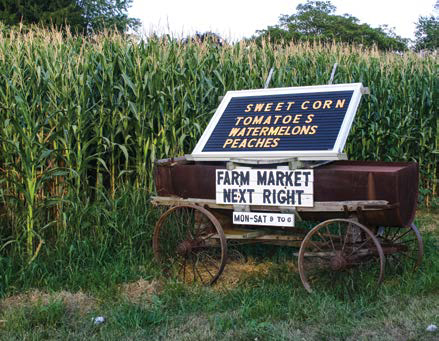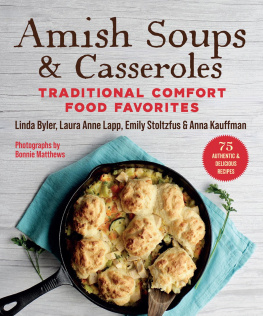Contents
Guide


Acknowledgments
 Special thanks to cousin Kaleb Wyse and Joel Kratzer for providing some of the photos found throughout the book. The Gray Boxwood blog was started by Joel (photography) and Kaleb, two good friends looking for an outlet for their creativity. Located amidst many Amish and Mennonite communities in eastern Iowa, Kaleb and Joels site is dedicated to creating a lifestyle that promotes comfort and pride in ones home by sharing ideas for decorating, gardening, cooking, building, and crafting. Learn more at www.thegrayboxwood.com
Special thanks to cousin Kaleb Wyse and Joel Kratzer for providing some of the photos found throughout the book. The Gray Boxwood blog was started by Joel (photography) and Kaleb, two good friends looking for an outlet for their creativity. Located amidst many Amish and Mennonite communities in eastern Iowa, Kaleb and Joels site is dedicated to creating a lifestyle that promotes comfort and pride in ones home by sharing ideas for decorating, gardening, cooking, building, and crafting. Learn more at www.thegrayboxwood.com.

Five recipes from
Amish Cooking appear in this book. 2017, 2019 by Fox Chapel Publishing Company, Inc., 903 Square Street, Mount Joy, PA 17552.
Amish Community Cookbook is a collection of new and previously published material.
Amish Community Cookbook is a collection of new and previously published material.
Portions of the text were previously published by Fox Chapel Publishing Company, Inc. in Treasured Amish & Mennonite Recipes (978-1-56523-599-1). Marked recipes on were previously published by Pathway Publishers Corporation in Amish Cooking. Print ISBN 978-1-4971-0000-8
eISBN 978-1-6076-5636-4 The Cataloging-in-Publication Data is available from the Library of Congress. To learn more about the other great books from Fox Chapel Publishing, or to find a retailer near you, call toll-free 800-457-9112 or visit us at www.FoxChapelPublishing.com. We are always looking for talented authors.
To submit an idea, please send a brief inquiry to . Cover designers: David Fisk and Kate Lanphier Editor: Katie Weeber Page designer: David Fisk Publisher: Alan Giagnocavo
Introduction
Amish and Mennonite food is often thought of as good old-fashioned, stick-to-your-ribs comfort food. But beyond the delicious, hearty taste, the food seems to offer something to nourish the soul. The recipes, handed down through generations, come from a time when families were closely connected to their land, raising, growing, and harvesting everything they consumed. The dishes are a reflection of the Amish and Mennonite culture, highlighting their European and agricultural heritage and the strong bonds of family and community that are such an important part of Amish and Mennonite life. The food is grown out of hard work and is made with love.
To understand what is so special about Amish and Mennonite food, it is helpful to know more about the culture.
A Very Brief History of Amish, Mennonites, and Anabaptism
The Amish and the Mennonites are part of a religious group whose members are found throughout the United States, Canada, and many other countries. The Mennonite church began in Switzerland in the early sixteenth century during the time following the Protestant Reformation of Martin Luther, maintaining two central beliefs. First, they rejected infant baptism, believing a Christian community should be made of adults who could knowingly and voluntarily confess their faith and choose to be baptized. Second, they believed the church should be a separate entity from the state.


In Amish communities, spring brings the arrival of mud salesno further explanation needed as seen above.
Occurring when fields are still too wet to till, mud sales are great social events for the Amish, other local farmers, and the plucky tourist or city dweller. When members of this Swiss group confessed their faith and baptized each other, they earned the name Anabaptizers or re-baptizers. At the time, these beliefs and actions were extremely radical, and many Anabaptists were heavily persecuted and their leaders killed. When persecution in Europe became too great, many members fled to the New World. In 1683, German-speaking immigrants established a Mennonite community in Pennsylvania, and during the next several decades, Mennonites continued to move west, establishing a presence throughout the country. Those who remained in Europe moved into Prussia (Poland) and then to the south of Russia at the invitation of Catherine the Great.
The many European wars of the 1800s and the Russian Revolution of the early 1900s caused many to move to the United States, Canada, and even South America. Nonresistance and pacifism are critical in Amish and Mennonites faith. The Amish and Mennonites, although part of the same religious group, sometimes differ in their fundamental beliefs about dress, their connection to mainstream society, and other similar religious and cultural matters. The Old-Order Amish follow the most conservative teachings, striving to maintain a pure, simple lifestyle. They separate themselves from the rest of the world to strengthen their beliefs and values, living without creature comforts like electricity, running water, and cars. The Amish choose to dress simply, in a manner they believe is called for in Scripture.
Women wear head coverings and do not cut their hair. All Amish clothing, both mens and womens, is made of solid colors and lacks adornments like buttons. This style of dress is meant to maintain simplicity and modesty in a world where glamour and immodesty can be highly emphasized. 
 Beyond their dress, the Amish are known for their policy of nonviolence and nonresistance, a belief that comes directly from the Biblical message to turn the other cheek. They also believe in community and communal support. The Amish feel it is their responsibility, and no one elses, to support and assist members of their faith.
Beyond their dress, the Amish are known for their policy of nonviolence and nonresistance, a belief that comes directly from the Biblical message to turn the other cheek. They also believe in community and communal support. The Amish feel it is their responsibility, and no one elses, to support and assist members of their faith.
As a result, the Amish do not accept any aid or welfare from the government or other organizations, choosing instead to depend on those around them for aid. While the Amish strictly adhere to and follow these beliefs, their practices are not typical of the larger, less-conservative segment of the Mennonite church. Most Mennonites have immersed themselves in modern society, living in houses with electricity and driving cars to and from work. What makes modern believers Mennonites is their continued adherence to the values of the Swiss reformers. Mennonites today still recognize the importance of maintaining a separation between church and state and believe that decisions about baptism, as well as church membership, should be made when adults. Along with their religious beliefs, the Mennonites have maintained much of their European cultural heritage.








![Beverly M Lewis] - The Beverly Lewis Amish Heritage Cookbook](/uploads/posts/book/96304/thumbs/beverly-m-lewis-the-beverly-lewis-amish-heritage.jpg)







 Acknowledgments
Acknowledgments  Special thanks to cousin Kaleb Wyse and Joel Kratzer for providing some of the photos found throughout the book. The Gray Boxwood blog was started by Joel (photography) and Kaleb, two good friends looking for an outlet for their creativity. Located amidst many Amish and Mennonite communities in eastern Iowa, Kaleb and Joels site is dedicated to creating a lifestyle that promotes comfort and pride in ones home by sharing ideas for decorating, gardening, cooking, building, and crafting. Learn more at www.thegrayboxwood.com.
Special thanks to cousin Kaleb Wyse and Joel Kratzer for providing some of the photos found throughout the book. The Gray Boxwood blog was started by Joel (photography) and Kaleb, two good friends looking for an outlet for their creativity. Located amidst many Amish and Mennonite communities in eastern Iowa, Kaleb and Joels site is dedicated to creating a lifestyle that promotes comfort and pride in ones home by sharing ideas for decorating, gardening, cooking, building, and crafting. Learn more at www.thegrayboxwood.com.  Five recipes from Amish Cooking appear in this book. 2017, 2019 by Fox Chapel Publishing Company, Inc., 903 Square Street, Mount Joy, PA 17552. Amish Community Cookbook is a collection of new and previously published material. Amish Community Cookbook is a collection of new and previously published material.
Five recipes from Amish Cooking appear in this book. 2017, 2019 by Fox Chapel Publishing Company, Inc., 903 Square Street, Mount Joy, PA 17552. Amish Community Cookbook is a collection of new and previously published material. Amish Community Cookbook is a collection of new and previously published material. 
 In Amish communities, spring brings the arrival of mud salesno further explanation needed as seen above.
In Amish communities, spring brings the arrival of mud salesno further explanation needed as seen above. 
 Beyond their dress, the Amish are known for their policy of nonviolence and nonresistance, a belief that comes directly from the Biblical message to turn the other cheek. They also believe in community and communal support. The Amish feel it is their responsibility, and no one elses, to support and assist members of their faith.
Beyond their dress, the Amish are known for their policy of nonviolence and nonresistance, a belief that comes directly from the Biblical message to turn the other cheek. They also believe in community and communal support. The Amish feel it is their responsibility, and no one elses, to support and assist members of their faith.